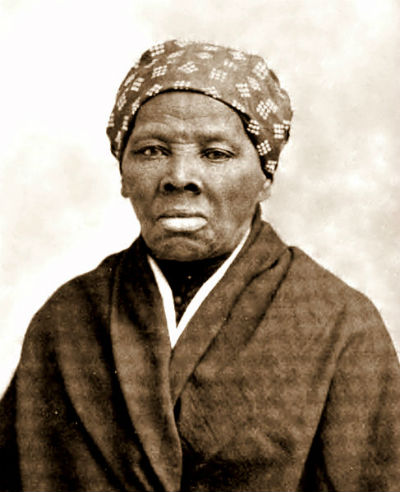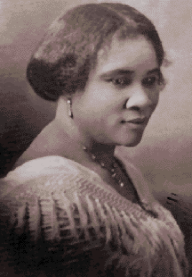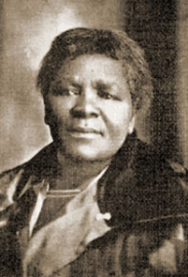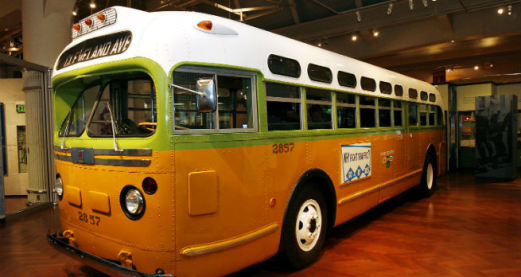 Harriet Tubman, photographed in 1895
Harriet Tubman was one of the great heroines of the struggle against slavery in nineteenth-century America. Born a slave herself, she was famous for escaping from her "owners", and then returning several times in secret to liberate many of her fellow slaves. The black freedom fighter John Brown reckoned her to be "one of the bravest persons on this continent". Her life still inspires people, and she is one of a select group of historical figures who holds a fascination for both public and scholars alike. So how did she become a rescuer of slaves, what did she contribute to the movement against slavery, and how should we see her today?
Harriet Tubman, photographed in 1895
Harriet Tubman was one of the great heroines of the struggle against slavery in nineteenth-century America. Born a slave herself, she was famous for escaping from her "owners", and then returning several times in secret to liberate many of her fellow slaves. The black freedom fighter John Brown reckoned her to be "one of the bravest persons on this continent". Her life still inspires people, and she is one of a select group of historical figures who holds a fascination for both public and scholars alike. So how did she become a rescuer of slaves, what did she contribute to the movement against slavery, and how should we see her today?
Tubman was born around 1820, at a time when the United States were already deeply divided about slavery. The southern states made extensive use of slaves, and were defiant about keeping them. The northern states did not have slavery, but they were obligated by the Fugitive Slave Act of 1793 to allow runaway slaves to be captured and returned to the South.
Any move to compel the South to abolish slavery was liable to cause it to split off from the union completely. The belief that slavery was a profound evil that would have to be abolished was gaining ground, both among concerned whites in the North, and among the slaves themselves. But such was the political deadlock that progress was stifled for decades.
In these years of frustration, one of the main hopes that slaves had of freeing themselves was escaping to non-slave territories in the North. This was a journey full of danger, and slave-owners often employed thugs to chase after and re-capture their "property". Many of those on the run were caught, and some died in the attempt. Those who got to the northern states could still be returned under the Fugitive Slave Act. The ultimate safe-haven was Canada, which refused to co-operate in any way with the pursuit of ex-slaves – but only the lucky ones made it this far.
The early escapees had to rely on their own resources. But gradually secret networks emerged to aid escape attempts, run by ex-slaves and sympathetic white abolitionists. By the 1840s they had come to be known as the "Underground Railroad".
In all, between 1850 and 1860, she made 19 trips and rescued over 300 people, without ever losing a "passenger" - an incredible feat!One of those brave enough to use the Railroad was Tubman. As a slave in Maryland, she had been exploited as child labour from the age of six, and in her early teens had been given a brutal blow to the head by an overseer, which was to give her feinting attacks for the rest of her life. By 1849 she had had enough, and she made her escape, armed with a deep religious faith that God would guide her. With the help of the Railroad, she escaped successfully to Philadelphia.
But her adventures were only just beginning. She joined an Underground Railroad organisation, and in the years that followed she returned to Maryland several times as a "conductor" who steered other slaves to freedom. In all, between 1850 and 1860, she made 19 trips and rescued over 300 people, without ever losing a "passenger" - an incredible feat!
To William Still, her co-worker on the Railroad, "she seemed totally devoid of fear". He judged that "in point of courage, shrewdness and disinterested exertions to rescue her fellow-men… she was without her equal".
Her Contribution to the Downfall of Slavery
Did the Underground Railroad, helped so much by Tubman's efforts, contribute to the ultimate downfall of slavery itself? Traditionally it has been claimed that up to 100,000 slaves were liberated by the Railroad, and if this is true, it certainly represented significant damage to the whole institution of slavery in the South. There are plenty of testimonies from the time and from the later memoirs of participants that support these figures. But are they to be believed?
In fact, historians have found the traditional figures to be exaggerated. If slaves had been migrating in these numbers, you would expect it to show up in census returns for the destination areas of north America and Canada, but little such evidence has been found. The Underground Railroad definitely existed, but it is unlikely to have been a single unified organisation, and it was on a smaller scale than was previously thought. Perhaps under 1,000 out of the three million people who were slaves escaped successfully each year, almost all from the northern parts of the South. Escape from the deep South was near impossible.
Northern abolitionists celebrated the Railroad as a mighty blow against the slave system. Tubman herself was in touch with the abolitionist leaders, and made public appearances at abolitionist rallies, despite her need for anonymity.However, the Underground Railroad was to challenge slavery in a more profound way, as what one might call a "propaganda device". In the 1840s and 1850s, the issue of fugitive slaves and the Railroad had a high public profile, and was one of the main areas of political contention between the North and the South. Northern abolitionists celebrated the Railroad as a mighty blow against the slave system. Tubman herself was in touch with the abolitionist leaders, and made public appearances at abolitionist rallies, despite her need for anonymity.
Meanwhile, southern slave-owners abhorred the Railroad as an illegal attempt to undermine the institution of slavery. This led the South, unwisely, to secure a harsher Fugitive Slave Act in 1850, which only served to increase support for abolition in the North. In short, the Railroad hastened the degeneration of political relations between North and South, and ultimately contributed to the outbreak of the Civil War in 1861, which resulted in victory for the North and the eventual abolition of slavery in 1865.
Tubman was not idle during the Civil War. She worked as a nurse on the Unionist side, and later became a spy for the Union army, again showing great bravery and resourcefulness. Military victory at last brought slavery to an end. But the human cost was extreme – over 600,000 Americans perished in the conflict – and the ex-slave communities would continue to face injustices and discriminatory laws for generations to come.
Harriet Tubman in Retrospect
The immediate post-war years treated Tubman badly – she was refused a military pension, and was left poor and still illiterate. However, her finances and public recognition improved dramatically when her admirer Sarah Bradford published an account of her life in 1869. After this, other stalwarts of the Railroad era told of her remarkable exploits, and gradually she came to be cherished as an icon of the battle against slavery. Over thirty years after the Civil War, she was awarded a military pension, and when she died in 1913 she was buried with full military honours.
Reverence for Tubman has grown ever since, with numerous books being written about her, including a veritable industry of books for children and youths which provide inspiring tales of her adventures. In 1944 Eleanor Roosevelt christened a ship after her, and her achievement has been commemorated with plaques, civic holidays, and even, in 1995, a postage stamp.
Women were prominent voices in the abolitionist movement as a whole, and that there were direct links between abolitionism and the origins of the feminist movement in America.So how should we remember Harriet Tubman today? Some would urge that her life is a striking reminder that African Americans played a crucial part in their own liberation. The southern slave-owners would have wanted us to believe that their slaves were content, and that abolition was a cause dreamt up by affluent northern white do-gooders. Tubman shows us that this was not so. The sufferings of black slaves were all too real, and there were highly able and committed slaves and ex-slaves who helped to fuel the abolitionist movement alongside their white abolitionist partners. The Underground Railroad was a case in point, in that it was fully "bi-racial", run by blacks and whites in collaboration.
Others might remark on how Tubman, a woman, achieved so much in a male-dominated age. She was very much her own person, independent, shrewd, and resourceful – it is easy to see why feminists would admire her! One should add here that women were prominent voices in the abolitionist movement as a whole, and that there were direct links between abolitionism and the origins of the feminist movement in America.
Tubman herself, though, might have chosen to be remembered first and foremost in a religious way, as someone who put her trust in the Lord, and who was used by God to achieve great things. In the religious language of the slaves' culture, she was known as "Moses", for the way in which she led her people out of their bondage, into the Promised Land of Liberty. Perhaps it was her faith that God would help her that gave her such fearless courage on the Railroad missions. Mind you, she kept a gun at her side just in case!
Editor's note: This article was updated on February 25th, 2014 to include extra detail




Rate and Review
Rate this article
Review this article
Log into OpenLearn to leave reviews and join in the conversation.
Article reviews